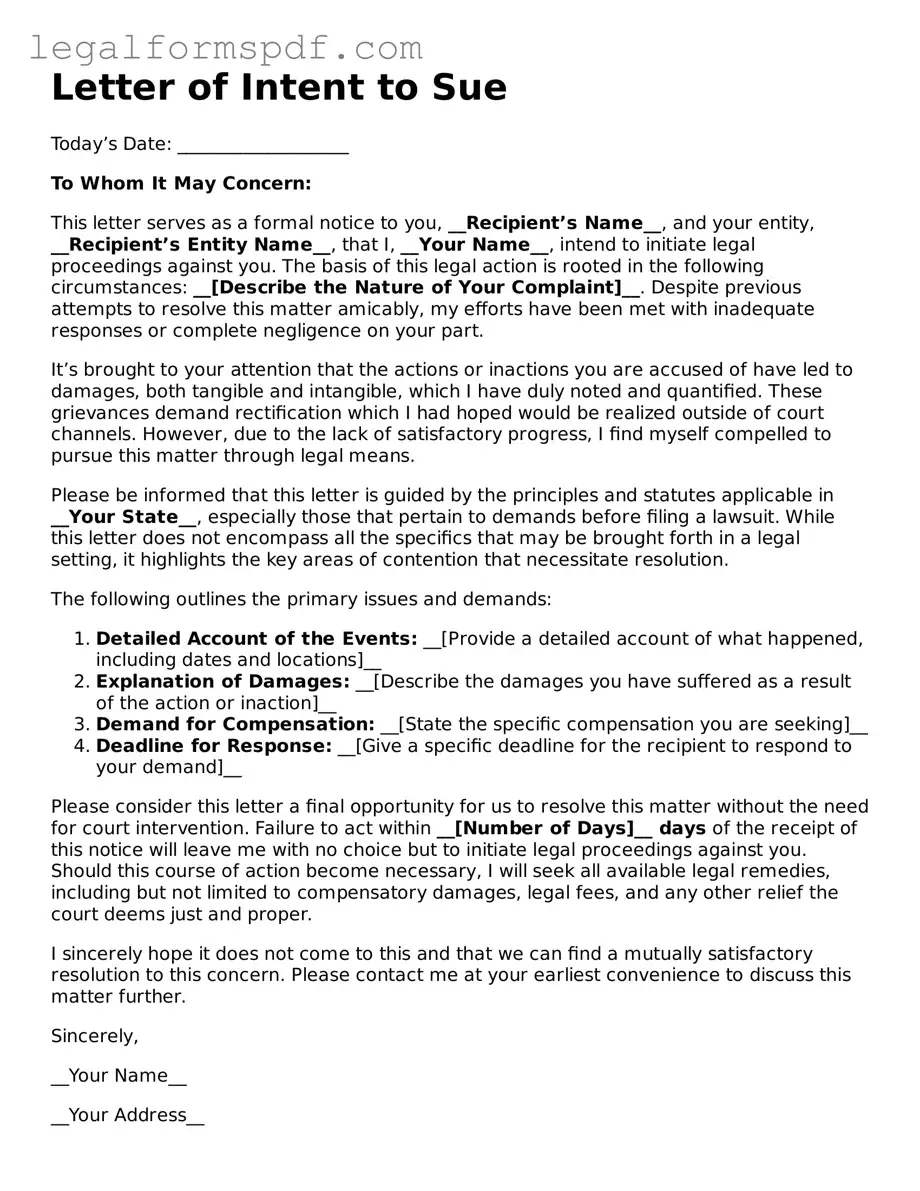A Demand Letter shares several similarities with a Letter of Intent to Sue, primarily serving as a formal declaration urging another party to fulfill a specific obligation, such as repaying a debt, before legal action is taken. Both documents are crafted to prompt a response or rectify a situation without needing to resort to litigation, while also providing a clear record of the sender's intentions and efforts to resolve the matter amicably.
The Cease and Desist Letter is another document that closely parallels the Letter of Intent to Sue. It is usually sent to halt alleged illegal activities or behaviors before they escalate further. While a Cease and Desist Letter doesn't necessarily threaten legal action outright, it implies that if the unwanted actions do not stop, legal steps, including a lawsuit, could be next, making it a precursor to a more direct threat such as the Letter of Intent to Sue.
An Eviction Notice also bears resemblance to a Letter of Intent to Sue in the context of landlord-tenant disputes. This notice is a legal document landlords provide to tenants to inform them of a lease violation and to vacate the premises by a specified date. Should the tenant fail to comply, the notice often indicates that legal action will ensue, similar to the warning provided in a Letter of Intent to Sue.
A Notice of Breach of Contract is a formal notification given to a party who has failed to perform as specified under a contract. Similar to the Letter of Intent to Sue, it specifies the nature of the breach and the remedies or actions required to cure it. The notice aims to provide an opportunity to resolve the issue out of court, much like the intention behind a Letter of Intent to Sue.
The Final Notice Before Legal Action is almost a direct synonym to the Letter of Intent to Sue, explicitly serving as the last warning to individuals or entities about pending legal action if certain conditions or obligations are not met. This document is typically used as a final attempt to settle disputes before moving forward with filing a lawsuit.
A Notice of Cancellation of Contract is utilized to formally terminate a contract and is similar to a Letter of Intent to Sue in that it is often used in situations where one party is not fulfilling their contractual obligations. While it primarily aims to nullify an agreement, it can also hint at or explicitly mention potential legal action if the cancellation does not resolve the dispute.
A Payment Demand Letter is focused specifically on the recovery of owed money and shares the preemptive qualities of a Letter of Intent to Sue. It serves as a formal request for payment while notifying the debtor that failure to comply may result in legal action. This document underscores the seriousness of the demand by embracing an official tone and often outlining the next legal steps.
The Notice to Quit, common in landlord-tenant law, is akin to a Letter of Intent to Sue but is more specific to ending a rental agreement due to violations such as non-payment of rent. While it serves as a prerequisite to eviction proceedings rather than a lawsuit for damages, the structure and strategic use are similar, aiming to achieve compliance before engaging in more serious legal measures.
A Warranty Claim Letter is sent to manufacturers or sellers in the event of a product failure, demanding remedial action under the terms of a warranty. Much like a Letter of Intent to Sue, it formally addresses a failure to meet agreed terms, and while its primary goal is to request a specific action (repair, replacement, or refund), it can imply or threaten legal action if the request is not honored.
The Legal Notice for Divorce parallels the Letter of Intent to Sue in its function as a precursor to court proceedings. This notice formally informs the other party of the intention to file for divorce and typically outlines the demands or conditions sought through the divorce action. It forewarns of the legal process and aims to provide an opportunity for resolution before extensive legal battles ensue.
